In March, an announcement landed quietly but landed hard. Publicis picked up Lotame. A month later, WPP had acquired InfoSum. To most people outside the marketing and media world, these names mean little. But inside ad-land, the acquisitions triggered a not-so-quiet panic about what had just changed, and what had just been lost.
The two companies were among the few remaining “neutral” infrastructure players in the increasingly fragmented world of advertising technology. They provided what are called clean rooms. secure, privacy-compliant platforms that allow companies to compare, analyse, and activate customer data without ever actually exchanging it.
They were Switzerland. Now they’re not.
“At first glance, it looks like a smart play by holding groups to bolster their data stacks ahead of a cookieless future,” wrote Matt Wilke, an omnichannel media specialist, in a LinkedIn post. “But hang on, what about the rest of us, particularly indie agencies and even rival networks?” For Wilke and many others in the independent agency and brand ecosystem, this wasn’t just a commercial development.
Platforms like InfoSum and Lotame had built their reputations on neutrality. They were not owned by adtech firms, not tied to publishers, and most importantly, not backed by holding companies. That meant indie agencies, challenger brands, and even rival networks could plug into them with confidence, knowing their clients’ first-party data wouldn’t end up in the hands of a competitor. Now, those very platforms are in the portfolios of two of the largest agency networks in the world. “Technically, we would be funding a competitor,” Wilke continued. “Every campaign run through these platforms now adds revenue to the holding group behind them. That’s not a comfortable proposition for many indies or challenger networks.”
He’s not wrong. Holding companies have long sought to own more of the advertising value chain, not just creative and media services, but data, identity resolution, and now, infrastructure. “These acquisitions will fundamentally reshape how cross-company data collaborations work. On the positive side, they could standardise and streamline partnership processes. However, they also introduce new power dynamics when data needs to flow between competing agency groups. We’ll likely see new governance models emerge to manage these complexities, particularly for advertisers working with multiple agencies,” Gopa Menon, chief growth officer – APAC, Successive Technologies, told financialexpress.com.
With InfoSum and Lotame, WPP and Publicis haven’t just acquired companies; they’ve acquired pipes. And when you own the pipes, you can decide what flows through them and what doesn’t.
“Data is the new oil. These kinds of acquisitions are about building a moat around competitive advantage. When creativity combines with data, identity, and technology, it becomes a salience game—and one that’s hard to replicate,” Sanjay Trehan, digital and new media advisor, said.
For holding companies, this isn’t just about cookieless advertising. It’s about being able to deliver personalised campaigns at scale, across walled gardens and open web alike, with consistent identity and measurable performance. And, increasingly, it’s about doing that without relying on external vendors. “To achieve scale and deliver precision in a cost-efficient manner is the desired outcome of these kinds of acquisitions. They need to be seen in the context of inorganic capability-building in a fast-evolving, ever-changing, hyper-competitive advertising world,” Trehan added.
But while the business case might be clear, the trust equation is far murkier. “With their recent acquisitions, the place and role of InfoSum and Lotame in the ecosystem have surely changed. The concern is that after being acquired by a holding firm, an independent data platform may no longer be seen as neutral,” Amitt Sharma, founder and CEO, VDO.AI, a video advertising technology company, added. Even if WPP and Publicis maintain firewalls, promise transparency, and keep the platforms ostensibly “open,” the perception of bias will linger.
“Trust is built and earned through neutrality and transparency,” Sharma added. “Clients, particularly independent agencies and brands, will naturally reassess their relationship because a layer of hesitancy is introduced when first-party data is placed on a platform that is currently owned by a possible rival.” It’s not an abstract concern. Agencies working with competing networks may now think twice before onboarding their data onto platforms where ownership and incentives are unclear. Brands may start inserting stricter data clauses into their contracts.
Even more fundamental is what this means for the clean room space itself. A space that, ironically, was meant to create interoperability across an increasingly fractured landscape. That ambition now looks increasingly compromised. “Big agencies are creating increasingly closed worlds for their customers. This helps them compete with Big Tech and provide integrated solutions, but it also raises questions about neutrality and interoperability,” Sharma added.
The irony is hard to ignore. In trying to compete with the walled gardens of Google, Meta, and Amazon, the holding companies may be building walled gardens of their own, just with better branding and more client dinners. “I feel this is just the beginning. The holding companies that haven’t made similar moves will undoubtedly be evaluating their options. Companies like Habu, LiveRamp, and Databricks’ clean room offerings could be attractive targets,” Menon added.
The stakes here are bigger than platform choice or vendor procurement. They’re about the shape of the future adtech landscape: whether it will be built around interoperable, neutral platforms that foster collaboration, or proprietary stacks controlled by a handful of powerful intermediaries.
Right now, the momentum is with the latter. But the pushback is growing.
